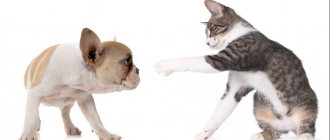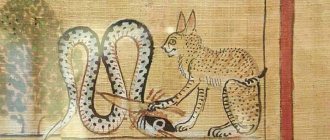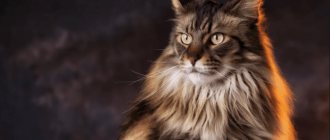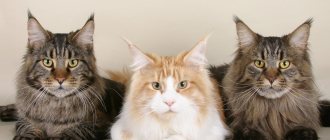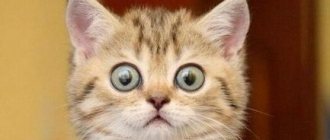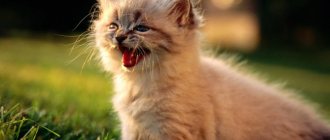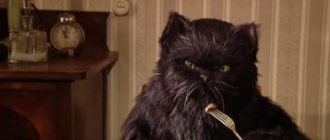There is an opinion that a cat is an animal that God created so that man would have a tiger that he could pet. Even in ancient civilizations, they thought that cats were connected with other worlds. In Egypt, these animals deserved the highest respect; they even had a cat-headed goddess, Bastet. If someone killed a cat in ancient Egypt, he was executed. In other countries, furry creatures have also earned attention in myths and legends. Look in the pictures at how cats were valued in different countries in ancient mythology!
Living without a cat is uncomfortable; it brings a special atmosphere to the house, and it is also believed that the animal lies on a sore spot and can heal it. But it’s not only modern humans who endow cats with magical powers. In the ancient worlds they were generally considered to be higher beings.
Cats in Ancient Egypt
The cat is a solar symbol, meaning royalty. In the mythology of the Egyptians, the cat was believed to be the sun that looked into the underworld at night, because both of them could see in the dark. In this state they were called Mau, which means “seer.”
The cat is a sacred animal of the sun god in Egypt. Legend has it that every night God turns into a red cat and swims across the Nile to illuminate the whole world at dawn.
Basque legends
The prototype of the famous character from the fairy tales of Charles Perrault is the Basque matagot, who eats Christians. The peoples who lived in the south of France and the north of Spain believed that if you catch this evil black creature, you can live without knowing troubles and sorrows for the rest of your life. You need to lure the cat with some kind of treat, manage to grab it and run at full speed without turning around.
Every morning, the matagot must be the first to taste the cooked food and drink a sip of wine. For this, the owners will receive a gold coin from him. But when a person becomes rich, he must definitely release the cat into the wild, otherwise the creature suffering in captivity will send illness and death to him.
INTERESTING TO KNOW: Determining the weather by a cat
Cats of the Ancient East
In the East, cats were credited with remarkable intelligence; they were called the eye of heaven. There, cats were associated with feminine power; they had a secret that they, like women, never revealed.
Because of their round eyes that glow in the dark, they were considered a mysterious animal that actively lives at night. It was believed that a cat could penetrate into other worlds and communicate with the inhabitants of the afterlife, therefore it was able to rid others of negativity.
Celtic legends
Irish and Scottish myths and legends about cats tell of the magical Shea - a black beast with a white spot on its chest and large protruding whiskers. He is not evil, but not good either. He can give back kindness to the people who treated him to delicious milk on Samhain (the Celtic harvest festival), or he can take with him the souls of the dead who did not have time to bury.
There is another version related to Shi. This is a werewolf witch who can change the appearance of a cat 8 times, but if she turns into an animal for the 9th time, she will remain one forever. Perhaps this legend is associated with the belief that cats have 9 lives.
But among English sailors there was a widespread legend about a sea cat. To appease her, you had to give her part of the catch, otherwise she could cause a storm. One day the witch went with her fiancé on a boat to the sea.
One of the sailors suggested throwing her overboard, since a woman on a ship is a bad omen. The sorceress became angry and caused a storm, during which all members of the ship died. And the witch herself jumped into the depths of the sea, where she turned into a cat.
Scandinavia
For residents of the Scandinavian countries, the cat was the companion of the goddess of love. Interestingly, she rode on a sled with cats.
The mythical cats, pictures of which you have seen, do not end there. Cats were special animals among almost all nations. They are still revered for their grace, dexterity, pleasant purring and are believed to help protect against evil spirits.
Epics of the Scandinavian peoples
In the Scandinavian epics, cats were described as companions of the goddess Freya - leader of the Valkyries, patroness of elves and fairies. Beautiful Freya rode across the sky in a chariot drawn by a pair of fluffy cats that looked like lynxes, with tufts on their ears. Who knows, maybe these mythical creatures were the ancestors of the famous skognat, now considered a national treasure of Norway?
INTERESTING TO KNOW: How do cats drink water?
No less widespread is the legend of the terrible black Yule cat, which appeared in Iceland in the 19th century. This huge monster, the size of a bull, lived in a mountain cave along with a cannibal giantess who kidnapped lazy and disobedient children. The cat appeared during Yule and took with him those who celebrated the holiday in old clothes.
The cat gave gifts to the same people who were not lazy in shearing wool from sheep, weaving and spinning before winter.
Mysterious vitality
Nature has given them several unique survival and recovery mechanisms:
- The ability to purr is an important property that helps relieve stress and launch healing mechanisms.
- An ideal sense of balance, thanks to the special properties of the vestibular apparatus, allows you to change the position of the body in space and fall on 4 paws when falling.
- Thanks to its ability to adapt, the cat quickly gets used to any situation and finds resources for life.
- Vibrissae are a unique mechanism that allows you to navigate the terrain. Thanks to him, the cat finds a home, being at any distance from it.
- The tissues of the cat's body are able to actively regenerate, which allows you to quickly cure an injury or fracture.
Modern scientists associate the endowment of animals with multiple lives in mythology with their ability to survive difficult situations, recover and recover from illness and injury.
How can we answer the question: how many lives does a cat have? Modern people understand: no matter how many lives are spoken of in ancient myths, in reality they are destined to live only one life. Therefore, cats need our attention, love and care no less than we do. But in return they bestow warm affection for many years, give joy and consolation in difficult moments of life.
How many lives do you think a cat has? Maybe you know the legends associated with them? We welcome feedback, questions and comments from our readers.
Treatment
Many people have stories of how these animals helped them cope with pain. There is even a whole system of treatment for cats, called feline therapy. It is used in case of cardiovascular diseases, problems with the musculoskeletal system, and high blood pressure. Cats also help people cope with depression.
Doctors give an explanation for why furry pets lie down on sore spots. This is due to their sensitivity to increased temperature, which allows them to detect the area of inflammation.
Cat and human home
Many people know the sign that the cat should be the first to enter the house. Nowadays, most people believe that this is due to the animal's ability to see and collect negative energy. In fact, the tradition arose due to the ability of cats to communicate with otherworldly entities, especially the brownie. It was believed that the furry assistant would be able to establish contact with him and thereby protect the new inhabitants of the home.
Cats have positive energy. The entire habitat of the animal and its inhabitants are subject to the influence of this force. If your pet is rubbing against your leg, it is not just hungry or seeking attention. He also transfers part of his powers. You should not offend the cat at such a moment; next time he will not show such favor.
Cats take time to exorcise. If an animal stays in one place for a long time and is preoccupied with something, it means something is wrong there. Having noticed such activity, you should perform a ritual of cleansing the place and read a prayer.
A cat present in the house protects its owners from the evil eye and damage. In difficult moments of life, you can take your pet in your arms and take advantage of its nourishment. To do this, you need to comb the animal’s scruff with your left hand. Also, such a procedure relieves tension, stress and improves well-being.
Japanese cat for good luck
In Japan, domesticated felines are feared and respected. What causes fear? In the East, a cat is a creature that can contact evil spirits. Japanese folklore ascribes to him the abilities of an energy vampire. Cats control the desire to feed on other people's energy.
Maneki-neko.
The Japanese consider cats to be the patrons of merchants. In souvenir shops today there is Maneki-neko - the bringer of good luck, or money cat. This is a porcelain or ceramic figurine of a cat with its front paw raised vertically. Antique samples are made of stone.
Today, such lucky cats are a constant attribute of most Japanese stores. People believe that they bring money, attract customers and bring good luck to entrepreneurs. It is not surprising that, along with other oriental talismans, Maneki-neko has become popular in Russia.
Cats were revered not only in Ancient Egypt. In the Land of the Rising Sun they were also respected. The first cats in this country belonged to the imperial family and had the status and privileges of courtiers.
At the forefront of scientific progress
However, cats and cats inspired not only writers - their mark on science is no less significant. A cat with the telling name Nicholas Copernicus, by the astronomer and cosmologist Edwin Hubble’s own admission, helped him with all his cat strength. After Copernicus examined all the sheets of the owner’s manuscripts, the mysteries of the expanding Universe were solved as if by themselves. In the 1960s, American intelligence developed Operation Acoustic Cat. In it, animals were supposed to be used to spy on Soviet embassy employees. Substantial funds were allocated for the operation: the training of “spies” and surgical operations cost the US government $25 million. Participants in the enterprise had microphones implanted under the skin next to their ears, and transmitting antennas were placed in their tails. In this way, the animals could receive and transmit signals, and their walks near the embassy did not arouse any suspicion. Despite all the work and material costs, the “Acoustic Cat” was a complete fiasco: the first purring cat, landed near the Soviet embassy in Washington, was immediately hit by a car. Other furry intelligence officers also did not live up to the expectations placed on them. It was almost impossible to control them, and they themselves were not at all eager to find out the political secrets of the USSR. At the beginning of the 21st century, the scientific world became preoccupied with cloning issues, and before creating a genetic copy of a person, scientists conducted experiments on animals. Employees at the University of Texas created a copy of Rainbow the cat by transplanting an embryo with her DNA into a surrogate mother named Ellie. It is interesting that while the Zoned cat is completely genetically identical to its mother, it differs from her in appearance. However, she is completely healthy and even became the mother of two kittens herself. And in 2010, a cat named Oscar served medicine: he became the first to receive prosthetics to replace his lost paws. The new design, called an “intraosseous percutaneous amputation prosthesis,” is similar in structure to porous deer antlers and allows metal to be attached directly to bone tissue. This fastening is much stronger than traditional dentures and, in addition, prevents dirt and bacteria from entering the joint. After Oscar became comfortable with his new paws, prosthetics were fitted to people, and they were all praised by patients for their convenience.
Age of New Kingdoms
The cult of Bastet, the most famous cat of ancient mythology, reached its peak at the beginning of the second millennium BC, during the reign of the 12th and 13th dynasties of the pharaohs. Her image in mythology was extremely positive.
“I am the cat, the mother of life,” the Egyptians wrote under the statues of Bastet, whom they depicted as a girl with a cat’s head. In her hand, the cat certainly held a sistrum, an ancient musical instrument, which can be considered a hint of nightly cat concerts. She was considered the patroness of motherhood, children and fertility, and was credited with the best traits, both feline and human.
Cats in the temple and at home
The center of Bastet became the city of Bubastis in the lower reaches of the Nile, where a huge temple was built in honor of the goddess. In 450 BC, this city was visited by the ancient Greek historian Herodotus, who described in detail what he saw. He calls the Bastet Temple the most pleasing to the eye in Egypt and talks about the festivals in honor of the cat goddess, which attracted people from all over the kingdom.
Up to one hundred thousand priests and even the pharaoh himself took part in these celebrations, which took place seven times a year. At the temple there lived cats, which were looked after by priests and priestesses; they also interpreted the behavior of temple cats, trying to find signs of divine powers in it.
The Greeks were also surprised by the general attitude of the Egyptians towards cats: they lived in every house and were considered members of the family. In the event of a house fire, it was cats, not children, that the Egyptians were the first to rescue. For killing a cat, voluntary or involuntary, the culprit was punished by death.
When a cat died, its family would go into mourning, and the cats would be embalmed and buried with honor, with their toys and food, such as mummified mice, placed in the sarcophagus. The cat necropolises discovered at Bubastis, Beni Hasan and Siut contained hundreds of thousands of cat tombs.
Militant Sekhmet
But even such an incredible love for cats did not prevent the Egyptians from seeing the other side of the cat. Her incarnation was the lioness goddess Sekhmet, a fearless and cruel warrior.
One of the Egyptian myths says that Sekhmet, sent to earth to protect people, fell into a rage and began to exterminate the human race. Not knowing how to stop her, the gods decided to spill wine on the ground. The lioness mistook it for blood, got drunk and, drunk, fell asleep.
Totem cat
People whose subconscious is connected with the character of cats are sweet, but independent, and what are called “walking on their own.”
These people are very clean and love their own body, both women and men prefer to take care of themselves, know how to take care of themselves, and are independent.
The health of these people seriously depends on the quality of sleep - with such a totem it is necessary to get a good night's sleep, this perfectly harmonizes the nervous system. Another aspect is sexual , this topic often becomes the most intrusive in their lives, but it is also a powerful driving force for their growth and development.
Cat painting by St. Petersburg artist Vladimir Rumyantsev
A person who has a cat totem has instinct and intuition, often hypersensitive abilities, and can clearly distinguish for himself Good and Evil, good and bad energy, light and dark people. He himself gravitates more towards one or the other pole.
They are curious and nosy, they love news and want to see and hear everything first. But they don’t aspire to be leaders; it’s more convenient for them to sit next to the leader, receiving all the benefits and bringing benefit with their talents and skills.
People who have a cat totem have good energy and can awaken their magical abilities and engage in various kinds of spiritual practices. Remember? - “There is no stronger beast than a cat!”
Woman with cat totem
- a girl-girl, very desirable for the male sex, she feels great potential - sexual and partner.
Feline flexibility and dexterity, grace are the qualities of true women who know how to enjoy life and attract men into their company.
The cat woman gets everything she wants with softness and affection, cunning and patience, and at the same time she knows how to arrange relationships so well that she will never allow herself to be offended. Otherwise, there is a reason to release her claws, which are quite sharp. Brunette cats are especially dangerous, they are absolutely on their own and very insidious, they do not forgive insults.
Cat painting by St. Petersburg artist Vladimir Rumyantsev
A woman whose cat is an animal of power has a developed maternal instinct, gets pregnant easily and loves to fuss with children. She is caring and knows how to instill in her offspring the necessary life skills.
She chooses professions where there will be a demand for her internal qualities - instinct, understanding of people, she can become a consultant and expert in various issues. She does not want a strict regime of professional activity; she prefers to work under a contract, in freelancing mode. Knows how to adapt, find loopholes and the best options for implementation in any event.
Men having a cat totem
– in their youth they are very active, striving for more and more new adventures. They know how to talk and captivate girls, value variety, and often have several love affairs at the same time.
They prefer to communicate with women; they have few male friends. In companies he is a pleasant and funny joker, attractive and sincere.
Cat painting by St. Petersburg artist Vladimir Rumyantsev
As they get older, they become lazier, agree to start a family, but are not averse to going “left” on occasion, without depressing themselves with doubts and feelings of guilt.
Cats, in general, love such living conditions when other people do everything for them, and they can come to a ready-made situation and decorate and ennoble it.
They work well in positions where commercial talent - a kind of merchant master who knows how to find an approach and cajole (mur-mur-mur) any potential partner or customer.
Their second talent is the ability to understand people and sense danger , so they find themselves in internal security services, especially commercial institutions. “Rats” - they smell it!
Kote the Pied Piper
They appear as fighters most often in only three situations:
- in situations of injustice, when they are severely deprived or their freedom is limited;
- in personal relationships, the presence of a rival invigorates them and forces them to activate their energy and mental abilities. Competition is their driving force;
- in extreme moments they instantly mobilize and are capable of feats.
Cat symbol - meanings
Cat symbolism is most suitable in the following situations:
- if you are sure that the cat is your animal of power , totem (“How to determine your totem”);
- if you were born in the year of the Cat according to the Eastern calendar: 1903, 1915, 1927, 1939, 1951, 1963, 1975, 1987, 1999, 2011;
- if your horoscope shows degrees associated with cat totems : 7 degrees of Aries (reed cat); 6 degrees Gemini (forest); 20 degrees Virgo (steppe); 2 degrees Sagittarius (Nubian); 11 degrees Sagittarius (tailless).
The symbol of a cat or cat as a talisman, amulet, talisman will be good in matters related to the realization of feminine energy - home improvement, keeping the family hearth, showing tenderness.
For a woman who needs to learn to set her own boundaries and love herself first, a cat is suitable as a symbol of compensation and reminder. She knows how to do well for herself and at the same time be useful and loved by others.
A wild cat or cat is a talisman, meaning life outside the rules, free, a person is able to move at the call of his nature. It is also a symbol that can impart the power of self-healing and use internal reserves.
Cats are an excellent logo for various security and safety services; their motto is: “Rats will not pass!”
The home mascot Cat in the interior as an object, an image - will help improve the home stay, add warmth and comfort to the atmosphere of the room. You can use a talisman or still prefer a real animal.
If you are engaged in practices of the astral level, then depending on your inclinations, either the symbol of a white or the symbol of a black cat . The white cat symbol will activate your connection with beneficial spirits. Conversely, a black cat is a symbol of the fact that you have chosen the lower world for your practices, be careful.
Ginger cat - can act as a sign in the field of love and sexual relationships. More details about this in the article “Is it true that a red cat is for love?”
Cat's eye is an amulet stone that protects its owner from negative energy and harmful influences from the outside. If, due to your activities, you are often in situations of danger or in an unfavorable external environment, learn to interact with this symbol or stone.
Bracelet with cat's eye
If you dream of a cat or several, it most often means the presence of someone else’s energy in your space, maybe it’s time for you to brighten your home and carry out cleansing procedures.
If a cat is your totem, then its image in a dream means the activity of your subconscious programs associated with the need to demonstrate its qualities. Analyze - perhaps you are holding yourself back and denying yourself some manifestations. Or perhaps this is a sign of anxiety and danger and you need to be more careful in situations and relationships.
On the topic - the section “Totems“
Tags: Talismans and amulets, Totems of birds and animals
- Related Posts
- Deer - symbol and totem
- Horse – symbol and totem
- Butterfly - symbol and totem
Discussion: 2 comments
- Taisiya:
10.20.2019 at 19:34Very interesting! I intuitively knew that the cat was my totem animal. They named it after Thais of Athens, and she was the queen of Egypt, and freedom for me is the main value, it coincided with the degrees in the horoscope - a steppe cat. I open an article on Wiki - please! 1 more hint: in Latin Felis silvestris is a European forest cat (subspecies), and my great-grandfather's name was Sylvester... coincidence? Don't think.
Answer
Admin:
10/25/2019 at 10:29 pm
Taisiya, cool. I love it when coincidences like this happen!
Answer
Legends about cats
Legends about cats were created by many peoples of Europe, Africa and Asia, only in America almost no myths were created about them, since the mustachioed and striped cats arrived there only in a limited contingent, along with settlers and conquistadors. The most popular myths about cats.
Slavic legends about cats
Our ancestors considered the cat to be the animal of Veles, the god of cattle, agriculture and poetry. That's why we all know Kot-Bayun - a huge monster that sits on an iron pole and puts heroes to sleep with its tales, and then eats them. However, Bayun could be caught and tamed, then his tales became therapeutic for the owner.
In addition, cats in Slavic mythology have always been associated with the brownie and the ovinnik; both guardians could turn into cats or communicate with him. Both also loved milk, which cats willingly shared with them, preferring mice.
In Bazhov's tales, which preserved the Ural factory legends for us, the Earthen Cat is often mentioned. In the Urals it was believed that this beast lives underground, and only its red, fiery ears stick out above the ground. Wherever such ears appear, the treasure is buried there. And this belief appeared, apparently, thanks to the sulfurous lights escaping from the mountain voids.
Scandinavian legends about cats
According to the Scandinavian Eddas, cats are the companions of the goddess Freya, the second oldest and most beautiful goddess of Asgard. The beautiful Freya, leader of the Valkyries, patroness of fairies and elves, loved to ride around the sky in a chariot drawn by two cats. These cats looked like lynxes - large, furry and with tufts on their ears. Apparently, the Norwegian forest cats, the national treasure of Norway, became their descendants.
In Iceland in the 19th century, a special legend about the terrible Yule cat appeared. This is a huge cat who lives with a cannibal who kidnaps lazy children. The Yule cat operates during Christmas time (Yule), eating anyone who has not managed to acquire a woolen new thing by this time. The legend was invented by parents so that their children would help them more actively in working with sheep and their wool - the main source of income for Icelanders.
Celtic legends about cats
The Shea Cat, found in Scottish and Irish legends, is a large black animal with a white spot on its chest. Apparently, myths about him appeared thanks to Kellas cats - semi-mythical hybrids of local forest cats and domestic cats brought by Roman legionnaires. Shea the cat is neither evil nor good. He can steal the souls of the dead before they are buried, or he can bless the house where he was fed milk on Samhain. According to another version, Shi Cat is a werewolf witch; she can only take off the form of an animal 8 times. If he turns into a cat in the 9th, he will take on this image forever. This is probably why we believe that a cat has 9 lives.
Another mythical Irish cat is Irusan, the king of cats. Irusan once attempted to kill a famous minstrel, but Saint Ciaran threw a red-hot rod at the cat, killed him and saved the poet.
The Welsh triads preserved stories about Shapalu or Kota Paluga - a terrible beast who, with its enormous claws, terrified settlements and devastated crops. This cat was given birth to the pig Henwen, who, fearing his evil, threw her offspring into the sea. But Palug survived because the peasants he had eaten when he grew up came out and picked him up. Only Sir Kay, one of the knights of the Round Table, was able to defeat the terrible cat.
The goddess Caridwen, the goddess of rebirth, transformation and inspiration, also lived in Wales. White cats served Caridwen - they transmitted her orders to the ground.
The British, among whom there were so many sailors and fishermen, had a legend about a sea cat. She definitely had to throw in some of the catch so she wouldn't get angry and cause a storm. The sea cat is a witch who once went on a boat with her fisherman fiancé. One of the sailors suggested throwing her overboard, since a woman on a ship is not good. The witch got angry, summoned a storm that scattered all the ships and killed all the fishermen, and then nevertheless jumped into the sea, but this time herself and in the form of a cat.
Legends about Basque cats
In northern Spain and southern France, the Basques and neighboring peoples believe in the wonderful cat Matagot. Matagot is an evil creature that appears in the guise of a black cat. Actually, it eats Christians, but if you catch it, you can ensure a comfortable existence for yourself. You should lure the matagot with a fish or chicken, grab it and run home without turning around. And then you need to give him the first bite of every dish and the first sip of every drink and receive for this a gold coin a day. Just remember to release the matagot when you become rich enough, otherwise you will die long and painfully until you give the creature freedom.
By the way, it was probably the matagot that was the prototype of the famous Puss in Boots.
Greek legends about cats
The supreme Greek god Zeus loved women very much and did not miss a single skirt. One of his chosen ones was Queen Alcmene, who bore the god a son, Hercules. However, Hercules was born for seven whole days, because Hera forced the midwife goddess Lucina to delay the birth of Alcmene. The jealous wife of Zeus wanted Hercules' cousin to be born first in the Perseus dynasty, so that the throne would not go to the divine bastard. But one of Alcmene’s maids, the red-haired Galanfida, told Lucina that the son of Zeus had already been born, despite all her efforts to prevent this. The goddess fell for it and allowed Alcmene to be relieved of her burden for real. In revenge, the angry Hera turned Galanfida into a cat and exiled her to the underworld to live alone. But cats are cute, and Hecate, the patroness of witches, healers and crossroads, took pity on the former servant, and so the cat became involved in witchcraft.
The Greeks also had another cat goddess - Ailuros (Eiluros), as they called the Egyptian Bast, but they identified her with the Moon, and, therefore, considered her to be the nocturnal incarnation of Artemis. In one myth, Artemis even turns into a cat to escape from the Titan Typhon. The name of the goddess Eiluros gave the name to the fear of cats - eilurophobia.
Legends about cats Roman
The cat, which walks on its own, became the companion of the goddess of freedom - Libertas - among the Romans. Libertas was worshiped by freedmen, former slaves, and therefore the cat also appeared on the banner of Spartacus’s troops.
Egyptian legends about cats
Today it is known for certain that cats were not domesticated in Egypt, but a little to the east - in the Fertile Crescent (from Mesopotamia to Anatolia). But only in the land of pyramids did these cute animals gain such impressive popularity. Of course, the main cat deity in Egypt was Bast, the patroness of women and the hearth. In addition, Bast was responsible for fertility and obstetrics, since cats have always been famous for their fertility and developed maternal instinct.
Also, the god Ra had a cat who helped him in the fight against the serpent Apep, so the cat in Egypt was associated with the sun, and its eyes, adjusting to the light, often served as a sundial.
Jewish legends about cats
Jews are a nomadic people of cattle breeders, so they did not often encounter cats. But among the Sephardic Jews there was a legend that Lilith (Adam’s first wife) turned into the demon cat El Brusha, who killed babies by drinking their blood.
Legends about Persian cats
In Persia (Iran) there are two legends about the origin of cats. The first is related to the saying “A lion sneezed and a cat was born.” One of the Persian historians wrote that the Creator, when creating the earth, forgot about cats, but did not forget about mice. The problem of lack of balance was clearly manifested in Noah's ark: mice multiplied during the journey and began to threaten the supplies designed for everyone. Then Noah asked the lion to sneeze, he obeyed and sneezed the cat. Stocks were saved.
Another Persian myth about cats is more ancient. One day, the hero Rustam, the hero of the Shahnameh epic, saved a magician from bandits. The magician, in gratitude, invited the hero to his tent and asked what to give him. Rustam was modest and said that he already had everything: the warmth of the fire, the pleasant smell of smoke and the starry sky above his head. Then the magician mixed smoke, fire and stars and handed Rustam a warm, smoky kitten, whose eyes shone like stars. This was probably the ancestor of the famous Persian breed.
Legends about Indian cats
The Indian goddess of childbirth and protector of children, Shasthi, was often depicted with the head of a cat or riding a cat. Initially, Shashkhti was an evil demon who sent diseases to newborns and women in labor, but later it was from her that women began to ask for protection and pregnancy.
The main god of the Indian pantheon, the thunderer Indra, was no less loving than Zeus, and therefore came to his mistresses in the form of a cat in order to deceive their husbands and admirers.
Chinese legends about cats
China had its own wild cats, and it seems they were domesticated there almost earlier than in Ancient Egypt. Therefore, the Chinese separated the domestic cat Mao and the forest cat Li.
The word "mao" consists of three characters that mean field, grass and monster, which is fair, because the cat protected the rice fields from mice and was a real monster for them. And “mao” is consonant with the Chinese word for “eighty,” which is why cats are often featured on greeting cards. According to one legend, Mao was bought by the sorcerer Miau-Kuau, who could resurrect the dead and heal people, so the cat became his companion. Also, the Chinese, like the Egyptians, determined time by cat's eyes.
Li was associated with the goddess Li Shou. When the gods created the earth, Li Shou volunteered to look after their creation. However, she wanted more to sleep under the cherry tree or play with flower petals than to watch what was happening. Then Li Shou refused both the position and the ability to speak, and proposed appointing a person in charge. However, man did not understand the gods, so Li Shou became the liaison between him and the creators.
There was also a cat goddess in China, Yifang Zhen, the leader of a legion of cats. However, besides this data, all that is known about her is that she and her legion fought for one of the ancient Chinese dynasties.
Legends about cats Japanese
The Japanese endowed many animals with magical abilities, and the cat did not escape this fate - it became a bakeneko werewolf. Any cat can become a bakeneko if it fulfills one of the following conditions: it weighs 1 kan (3.75 kg), has a long tail, or lives to be 13 years old. Moreover, long-tailed cats had a tail that forked, and they turned into “forked cats” - nekomata, a special separate type of bakeneko. According to legends, werecats could eat their owner and take his form or revive the dead by jumping over him. The bakeneko were also capable of creating ghostly fireballs and walking on two legs. Most often, cats are possessed by the spirits of dead women who want to take revenge on their husbands. This is probably why Japanese bobtails appeared in the land of the rising sun - cats of an elegant build, with short tails, almost incapable of becoming a bakeneko.
But there is also a lucky cat in Japan - maneki-neko. The traditional maneki-neko is a figurine of a white cat with or without red and black spots, which holds one or two paws raised in a gesture of invitation (calling for money, clients, luck). Sometimes in the lowered paw of the talisman lies a gold coin worth 10 million ryo; even more often it is decorated with a breastplate similar to the breastplate of Buddha-Jizo, the patron saint of children and travelers. There are three versions of the appearance of maneki-neko. In the first, the cat began to invite guests to an abandoned monastery, and thanks to her, the monastery flourished again; in the second, a cat saved a highly qualified prostitute from a snake; in the third, she appeared in a dream to a poor housewife, who kicked her out, and advised her to sculpt cats from clay, which ensured the old woman a comfortable old age. And Maneki-neko took the coin from the legend about a cat who stole two gold coins from his rich owner for his sick poor neighbor who fed the cat fish.
Another Japanese belief says that a white cat with a spot on its back is the transmigrated soul of a person, because such spots look like a kimono.
Legends about cats Thai
According to Thai beliefs, cats were possessed by the souls of the dead, so they were buried in crypts along with their owners, but so that the animals could get out. For the same reason, cats were often present at the coronations of the kings of Siam and the burial ceremonies of Buddhist teachers.
Thai and Siamese cats often have knots on their tails, now considered a breeding defect caused by inbreeding, but these cats used to be called "royal". The fact is that there is a legend about the royal daughters who strung their rings on the tails of their beloved pets while bathing. To prevent these rings from falling, the cats “grew” knots.
About 20 breeds of cats were known in Thailand, a book of poems was even written about them, and therefore legends here were formed not only about the well-known Siamese and Thais, but also about others - for example, about the Korats. Korats in the region where they come from regularly participate in rituals to bring rain and are considered a good wedding gift as they promote fertility.
American cat legends
As already mentioned, domestic cats came to America late, but wild cougars, jaguars, lynxes, etc. have always been found here, and therefore part of the beliefs about them transferred to cats. So, in Northern Mexico and Arizona there is a legend about a cactus cat covered with thorns and making pulque vodka. Such a cat, if he makes pulque and gets drunk, will bring a lot of trouble to those who fall under his paw.
But in Nevada, a cat was once tried for killing a baby; this trial was associated with a legend brought by settlers from England - cats take the breath away from children. But most likely, big cats could actually crush weak children while sleeping together.
At the end of the 20th century in the USA, thanks to psychologist Paul Dame, William Briton and Dr. Wallace Syfe, a legend arose that cats, after death, end up on the magical Rainbow Bridge, where they live in warmth and care, waiting to meet their owners when they come. term.
Argentines also have their own legend; they believe that the mysterious Ombre Gatto (Shadow Cat) or Catman, a werecat who is not averse to attacking people, wanders the streets of cities.
Legends about cats are numerous and varied, but they all agree on one thing: cats are amazing creatures, our guides to the other world.
Cats caused the Black Death
In the Middle Ages, cats were usually considered sinister animals, possessing essentially the same powers as witches and sorcerers.
A cat's bite was considered poisonous, as was their flesh. If you inhale the breath of a cat, you will become infected with consumption. They can also make your beer sour if they want.
Thus, when the bubonic plague swept the European continent in the 14th century, killing up to 60% of the population, in some regions it was naturally assumed that this was the work of the Devil, and more specifically his feline minions.
A huge number of cats, especially black ones, were destroyed during this wave of plague, and sometimes their owners along with them. This, of course, was ill-advised, because the real spreader of the plague was rats, and cats helped control their population.
Cats bring good luck, but not all of them
The Maneki Neko is an iconic Japanese talisman that is believed to bring good luck to its owner, usually in the form of money. One legend explains that a Japanese cat once waved its paw to lure its owner into the house. This saved him from being struck by lightning moments later, which is why a cat waving its paw is considered a good gesture. Tortoiseshell cats are also considered lucky in Japan, especially the rare males.
According to Buddhist belief, a dark-haired cat promises gold, while a light-haired cat promises silver.
Many cultures think that polydactyly (extra toes) in cats is a good luck charm.
It is said that sailors who sailed to America usually took multi-toed cats with them to ensure a safe voyage.
Festive palette
In 2002, the International Fund for Animal Welfare celebrated World Cat Day for the first time. The holiday was invented not only to honor furry pets. Cat Day was designed to draw attention to homeless animals, their diseases and cruelty to them. The celebration soon gained popularity, and today it is joined by millions of “cat lovers” from different parts of the globe. Every year on August 8th, owners of mustachioed tabbys are simply obliged to pamper their pets especially: treat them to something tasty, please them with a new cozy house or an interesting toy. Knowing the cat's passion for comfort, the owners of specialized businesses schedule the opening of hotels, cafes and shops intended for furry visitors on this day. And TV channels produce programs dedicated to the heroes of the occasion. In the diverse palette of “cat” holidays, there are many other days dedicated to purring. On June 8, St. Petersburg residents honor their cats, and on September 5, Kaliningrad residents. November 17 is the Black Cat Day celebrated in Italy, February 17 is Cat Day in Poland, March 1 is Russian Cat Day. And on March 27, a holiday comes for the chosen few - cats living in the St. Petersburg Hermitage, the Day of the Hermitage Cat. In other words, there are more than enough reasons to congratulate cats in the world. But it is International Cat Day that is a common big holiday for all lovers of these amazing animals around the globe.
Magazine: Secrets of the 20th Century No. 32, August 2022 Category: Continuous Holidays Author: Ekaterina Kravtsova
Tags: legend, tradition, Secrets of the 20th century, mythology, myth, cat, magic, holiday, Celts, Bulgakov, The Master and Margarita, Samhain, fairy tale, cat
- Back
- Forward
Secret power
Psychic Arina Evdokimova calls cats an energy clot that cannot be destroyed. According to her, this is precisely what explains the notorious 9 cat lives. Fluffy animals, finding themselves in a deadly situation or falling from a great height, are able to simply reincarnate. Unfortunately, people cannot see this process.
Zoologist Anastasia Antonevich offers another explanation for the amazing vitality of furry animals. She believes that their genetic code was shaped by the wild conditions in which cats existed before domestication. They have a very flexible body, they climb a lot, know how to jump and fall correctly, and can go without food for a long time.
